Contents
- Indian, Afghan officials discuss Loya Jirga
- SC: Daughters have equal birthright to inherit property
- Is economy recovering with easing of lockdown or sinking?
- Fitch on RBI’s debt revamp proposal
- Jammu and Kashmir to get limited 4G access
- Russia registers coronavirus vaccine
INDIAN, AFGHAN OFFICIALS DISCUSS LOYA JIRGA
Focus: GS-II International Relations
Why in news?
- Indian and Afghan officials in Delhi and Kabul discussed the outcome of the Loya Jirga, or grand assembly, in Afghanistan that advised the release of 400 Taliban militants convicted of serious crimes.
- The two sides discussed the likelihood of intra-Afghan negotiations in Doha, Qatar, as well as the hopes for a permanent ceasefire.
- The Loya Jirga has been convened after the Afghanistan President refused to release the Taliban prisoners which threatened the derailment of intra-Afghan talks.
Details
- The release was conditional, and contingent on a reduction in the level of violence by the Taliban as well as a “humanitarian ceasefire” for civilians to be transported during the coronavirus pandemic without fear of the Taliban.
- The Taliban is also required to guarantee that none of the men being released will return to combat.
- It is hoped that the release of the Taliban prisoners will include those demanded in exchange for the release of the Indian hostage.
- Talks are also on for the release of the last of the group of seven Indian hostages still held by the Taliban following their abduction in 2018.
Loya Jirga
- Loya Jirga is a mass national gathering that brings together representatives from the various ethnic, religious, and tribal communities in Afghanistan.
- It is a highly respected centuries-old consultative body that has been convened at times of national crisis or to settle national issues.
- Even though Loya Jirga is not an official decision-making body and its decisions are not legally binding, the Loya Jirga’s decision is seen as final, with the president and parliament expected to respect the ruling.
U.S.A.’s Role in Afghanistan
- The prisoner exchanges are part of the agreements signed by the USA and Taliban and the USA and Afghanistan government earlier in 2020.
- The USA government has been keen to speed up the Taliban-Afghan reconciliation process and the USA believes that the talks between the Afghanistan government and Taliban will lead to reduction of violence and direct talks, resulting in a peace agreement and an end to the war in Afghanistan.
- The USA announced to withdraw its forces and reduced their strength, after pushing for the Afghanistan government to release the Taliban prisoners, and for the Taliban to release Afghan soldiers and civilians in its custody.
Afghanistan–India relations
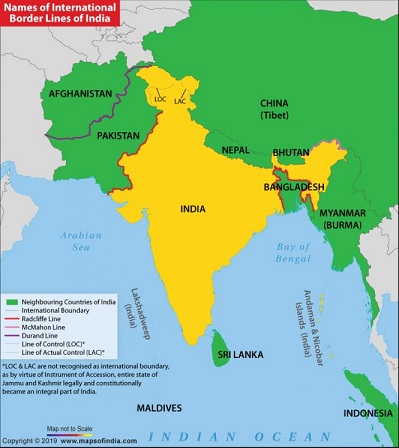
- Bilateral relations between Afghanistan and India have remained strong and friendly over the decades, tracing back to the Indus Valley Civilisation.
- Between the 10th century to the mid-18th century, northern India has been invaded by a number of invaders based in what today is Afghanistan. Among them were the Ghaznavids, Ghurids, Khaljis, Suris, Mughals and Durranis.
- The Republic of India was the only South Asian country to recognize the Soviet-backed Democratic Republic of Afghanistan in the 1980s.
- India-Afghanistan relations were diminished during the 1990s Afghan civil war and the Taliban government.
- India aided the overthrow of the Taliban and became the largest regional provider of humanitarian and reconstruction aid to the present day Islamic Republic of Afghanistan.
- India shares border with Pakistan and there is the Durand Line conflict between Pakistan and Afghanistan.
Concerns for India with the U.S. – Taliban Peace deal
- The U.S.-Taliban peace deal means that the Taliban, which has not let up on violent attacks on the Afghan Army, will become more potent as the U.S. withdraws soldiers from the country, and will hold more sway in the inter-Afghan process as well, as the U.S. withdraws funding for the government in Kabul.
- India’s presence inside Afghanistan, which has been painstakingly built up since 2001, is being threatened anew by terror groups such as the Islamic State Khorasan Province (ISKP), believed to be backed by Pakistan’s establishment.
- Afghanistan is a strategic investment for India, and India has made significant contributions to the rebuilding of the country. India’s assistance of more than $3 billion in projects, trade of about $1 billion, a $20 billion projected development expenditure of an alternate route through Chabahar, as well as its support to the Afghan National Army, bureaucrats, doctors and other professionals for training in India should assure it a leading position in Afghanistan’s regional formulation.
India’s terms would be revolving around:
- Taliban commitments on India’s strategic projects, and Chabahar port,
- The safety of minorities, women’s education
- Terrorism, where no Afghan soil could be used by anti-India groups.
India’s Interest in Afghanistan
- Economic and Strategic Interest: Afghanistan is a gateway to the oil and mineral-rich Central Asian republics.
- Afghanistan’s main advantage is its geography, as anyone who is in power in Afghanistan controls the land routes connecting India with Central Asia (via Afghanistan).
- Developmental Projects: The massive reconstruction plans for the country to offer a lot of opportunities for Indian companies.
- Three major projects: The Afghan Parliament, the Zaranj-Delaram Highway, and the Afghanistan-India Friendship Dam (Salma Dam), along with India’s assistance of more than $3 billion in projects, hundreds of small development projects (of schools, hospitals and water projects) have cemented India’s position in Afghanistan.
- Security Interest: India has been the victim of state-sponsored terrorism emanating from Pakistan supported terrorist group operating in the region (e,g., Haqqani network).
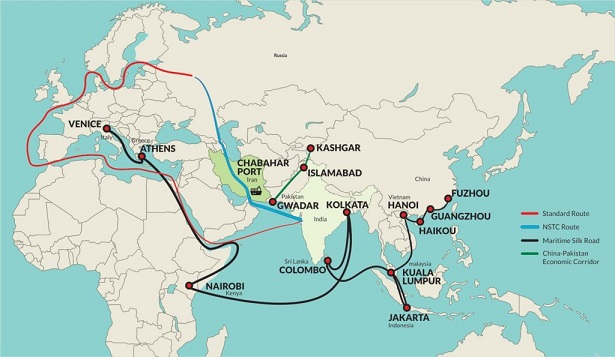
-Source: The Hindu
SC: DAUGHTERS HAVE EQUAL BIRTHRIGHT TO INHERIT PROPERTY
Focus: GS-II Governance, Social Justice,
Why in news?
The Supreme Court held that daughters, like sons, have an equal birthright to inherit joint Hindu family property. The judgement came on the issue whether the amendment to the Hindu Succession Act, 1956, granting equal rights to daughters to inherit ancestral property would have retrospective effect.
Details
- The Supreme court decided that the amended Hindu Succession Act, which gives daughters equal rights to ancestral property, will have a retrospective effect.
- The judgment agreed that the substituted Section 6 of the Hindu Succession Act, 1956 confers the status of ‘coparcener’ to a daughter born before or after the amendment in the same manner as a son.
Coparcener is a person who has a birthright to parental property.
- The court larified that an unregistered oral partition, without any contemporaneous public document, cannot be accepted as the statutory recognised mode of partition.
- However, in exceptional cases where plea of oral partition is supported by public documents and partition is finally evinced in the same manner as if it had been affected by a decree of a court, it may be accepted.
-Source: The Hindu
IS ECONOMY RECOVERING WITH EASING OF LOCKDOWN OR SINKING?
Focus: GS-III Indian Economy
Why in news?
- Most high frequency indicators suggest a sequential recovery until June 2020, with a flattening in July.
- The latest Consumer Confidence Survey (CCS) of the Reserve Bank of India shows that people believe that the economic situation was much worse in July than in May when compared to year-ago levels.
- This suggests that India’s GDP might remain in contraction mode in the September quarter.
- The CCS also suggests that some key high frequency indictors might not be capturing the actual magnitude of distress.
Significance of CSS
- A comparison of current perception on general economic situation in the CCS along with quarterly GDP figures shows that they have pretty much moved in tandem.
- This suggests that there is a high probability that the unprecedented collapse in May and July CCS might reflect in GDP numbers as well.
- Interestingly, the CCS response on employment does not seem to be in sync with the only monthly indicator of unemployment rates available in India, which are collected by the Centre for Monitoring Indian Economy (CMIE).
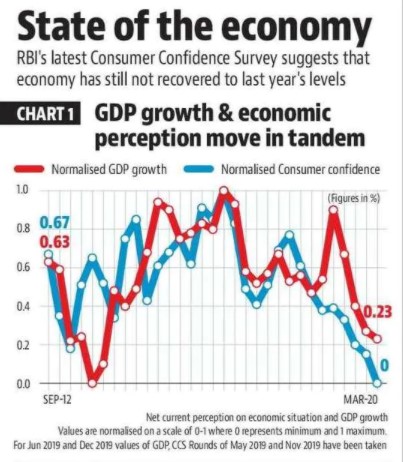
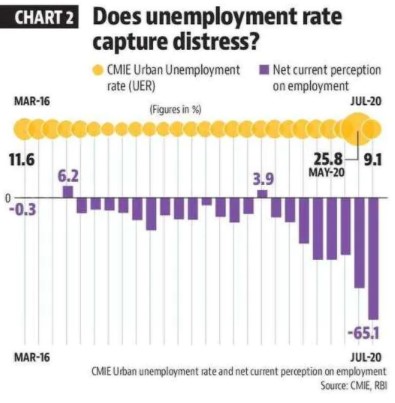
Does the CCS not capture the reality of the labour market?
A research note says that while unemployment rates might come back to normal, wage outlook could be dimmer than in the pre-pandemic world.
Reasons:
- More jobs being generated in the rural areas where wages are lower.
- A second-round-pandemic-led global weakness in labour markets due to job losses in the first round.
- Expectations of lower economic growth, an important driver of wages.
-Source: Hindustan Times
FITCH ON RBI’S DEBT REVAMP PROPOSAL
Focus: GS-III Indian Economy
Why in news?
A one-time debt restructuring allowed by the Reserve Bank of India (RBI) to help lenders and borrowers amid the COVID-19 pandemic will prolong uncertainty about the banking sector’s asset quality, Fitch Ratings said.
Details
- The policy could open a window for banks to build capital buffers while putting off full recognition of the coronavirus pandemic’s impact on loan portfolios, but is reminiscent of a strategy adopted over 2010-2016 that delayed and exacerbated problems for the banks.
- Indian banks are saddled with more than $120 billion in bad loans and the sector is ranked the third-worst among 13 major world economies in asset quality
- The central bank has set up a committee to oversee restructuring plans involving creditors with more than 15 billion rupees of debt, but that is likely to leave out lending to retail and small- and medium-sized firms, which Fitch said is likely to account for a substantial portion of future pandemic-linked asset quality stress.
Lessons from the past
- The central bank’s experience with loan restructuring in the past hasn’t been encouraging.
- In several instances the restructuring method was used for evergreening of loans, a practice in which banks provide additional loans to stressed borrowers, often indirectly, to enable them to repay existing loans.
-Source: Thet Hindu, VCCircle
JAMMU AND KASHMIR TO GET LIMITED 4G ACCESS
Focus: GS-II Governance
Why in news?
- In the last hearing, the court asked the Centre to explain whether 4G network could be restored in select areas of Jammu and Kashmir where there was no trouble.
- Attorney General informed the Supreme Court that 4G Internet access will be opened up after Independence Day in one district in each of Jammu and Kashmir’s divisions.
- The “carefully calibrated” opening up of 4G access would be on a trial basis.
Details
- The Centre, however, said a blanket removal of the 4G ban was not possible now, considering the “overall situation” and “threat perception” to national, border and local security.
- The access will be limited to specified areas that are not adjacent to the international border and have seen “low intensity terrorist activities”.
- Access will be strictly monitored to protect national, border and local security.
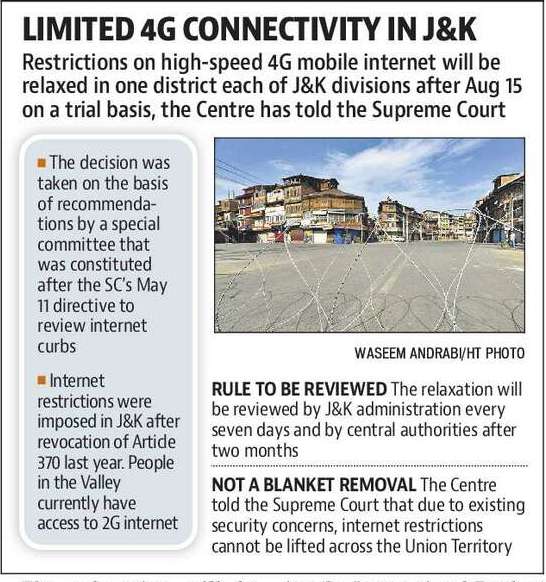
-Source: The Hindu
RUSSIA REGISTERS CORONAVIRUS VACCINE
Focus: GS-III Science and Technology
Why in news?
- Russia became the first country to officially register a coronavirus vaccine and declare it ready for use, despite international skepticism.
- President Vladimir Putin said that one of his daughters has already been inoculated.
Details
- Scientists in Russia and abroad have been sounding the alarm that the rush to start using the vaccine before Phase 3 trials — which normally last for months and involve thousands of people — could backfire.
- Russian authorities have said that medical workers, teachers and other risk groups will be the first to be inoculated.
- The Russian Health Ministry said that the vaccine is expected to provide immunity from the coronavirus for up to two years.
- It was emphasized that vaccination will be voluntary.
- Becoming the first country in the world to develop a vaccine was a matter of national prestige for the Kremlin as it tries to assert the image of Russia as a global power.
The Russian “Sputnik V” vaccine
- The vaccine is administered in two doses and consists of two serotypes of a human adenovirus, each carrying an S-antigen of the new coronavirus, which enter human cells and produce an immune response.
- The platform used for the vaccine was developed by Russian scientists over two decades and had formed the basis for several vaccines in the past, including those against Ebola.
-Source: The Hindu




